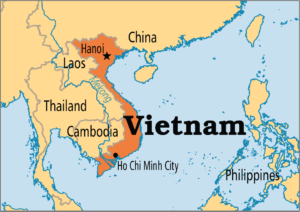IASbaba Daily Prelims Quiz
For Previous Daily Quiz (ARCHIVES) – CLICK HERE
The Current Affairs questions are based on sources like ‘The Hindu’, ‘Indian Express’ and ‘PIB’, which are very important sources for UPSC Prelims Exam. The questions are focused on both the concepts and facts. The topics covered here are generally different from what is being covered under ‘Daily Current Affairs/Daily News Analysis (DNA) and Daily Static Quiz’ to avoid duplication. The questions would be published from Monday to Saturday before 2 PM. One should not spend more than 10 minutes on this initiative.
This is a part of our recently launched, NEW INITIATIVE IASbaba’s INTEGRATED REVISION PLAN (IRP) 2020 – Road Map for the next 100 Days! FREE INITIATIVE!
We will make sure, in the next 4 months not a single day is wasted. All your energies are channelized in the right direction. Trust us! This will make a huge difference in your results this time, provided that you follow this plan sincerely every day without fail.
Gear up and Make the Best Use of this initiative.
Do remember that, “the difference between Ordinary and EXTRA-Ordinary is PRACTICE!!”
To Know More about the Initiative -> CLICK HERE
SCHEDULE/DETAILED PLAN – > CLICK HERE
Important Note:
- Don’t forget to post your marks in the comment section. Also, let us know if you enjoyed today’s test 🙂
- After completing the 5 questions, click on ‘View Questions’ to check your score, time taken and solutions.
Test-summary
0 of 5 questions completed
Questions:
- 1
- 2
- 3
- 4
- 5
Information
To view Solutions, follow these instructions:
- Click on – ‘Start Test’ button
- Solve Questions
- Click on ‘Test Summary’ button
- Click on ‘Finish Test’ button
- Now click on ‘View Questions’ button – here you will see solutions and links.
You have already completed the test before. Hence you can not start it again.
Test is loading...
You must sign in or sign up to start the test.
You have to finish following test, to start this test:
Results
0 of 5 questions answered correctly
Your time:
Time has elapsed
You have scored 0 points out of 0 points, (0)
| Average score |
|
| Your score |
|
Categories
- Not categorized 0%
| Pos. | Name | Entered on | Points | Result |
|---|---|---|---|---|
| Table is loading | ||||
| No data available | ||||
- 1
- 2
- 3
- 4
- 5
- Answered
- Review
-
Question 1 of 5
1. Question
Consider the following statements with respect to SERB-POWER scheme:
- It is launched under the Ministry of Science and Technology
- The scheme targets women researchers in 18-55 years of age.
Which of the above statements is/are correct?
Correct
Q.1) Solution (a)
The Union Minister for Science and Technology has launched SERB-POWER (Promoting Opportunities for Women in Exploratory Research) Scheme, which has two components of fellowship and research grants.
The Science and Engineering Research Board (SERB), is a statutory body of the Department of Science and Technology (DST), Government of India.
Key Points
- It is a scheme designed exclusively for women scientists to mitigate gender disparity in science and engineering research in various science and technology (S&T) programmes in Indian academic institutions and research and development (R&D) laboratories.
- It will serve as a benchmark of recognition in the national scenario and will empower women scientists and cultivate a women-friendly culture and ensure more women in leadership positions in decision-making bodies.
SERB-POWER Fellowship:
Target:
- Women researchers in 35-55 years of age.
- Up-to 25 Fellowships per year and not more than 75 at any point in time.
Components of Support:
- Fellowship of Rs. 15,000/- per month in addition to regular income.
- Research grant of Rs. 10 lakh per annum.
- Overhead of Rs. 90,000/- per annum.
Duration:
- Three years, without the possibility of extension. Once in a career.
Incorrect
Q.1) Solution (a)
The Union Minister for Science and Technology has launched SERB-POWER (Promoting Opportunities for Women in Exploratory Research) Scheme, which has two components of fellowship and research grants.
The Science and Engineering Research Board (SERB), is a statutory body of the Department of Science and Technology (DST), Government of India.
Key Points
- It is a scheme designed exclusively for women scientists to mitigate gender disparity in science and engineering research in various science and technology (S&T) programmes in Indian academic institutions and research and development (R&D) laboratories.
- It will serve as a benchmark of recognition in the national scenario and will empower women scientists and cultivate a women-friendly culture and ensure more women in leadership positions in decision-making bodies.
SERB-POWER Fellowship:
Target:
- Women researchers in 35-55 years of age.
- Up-to 25 Fellowships per year and not more than 75 at any point in time.
Components of Support:
- Fellowship of Rs. 15,000/- per month in addition to regular income.
- Research grant of Rs. 10 lakh per annum.
- Overhead of Rs. 90,000/- per annum.
Duration:
- Three years, without the possibility of extension. Once in a career.
-
Question 2 of 5
2. Question
Vietnam does not share land border with which of the following country?
Correct
Q.2) Solution (a)
Vietnam shares its land borders with China to the north, and Laos and Cambodia to the west. It shares its maritime borders with Thailand through the Gulf of Thailand, and the Philippines, Indonesia and Malaysia through the South China Sea.
 Incorrect
Incorrect
Q.2) Solution (a)
Vietnam shares its land borders with China to the north, and Laos and Cambodia to the west. It shares its maritime borders with Thailand through the Gulf of Thailand, and the Philippines, Indonesia and Malaysia through the South China Sea.

-
Question 3 of 5
3. Question
Which of the following statements is not correct with respect to Jute cultivation?
Correct
Q.3) Solution (d)
Jute cultivation
- Temperature: Between 25-35°C.
- Rainfall: Around 150-250 cm.
- Soil Type: Well-drained alluvial soil.
- Top Jute Producing States: West Bengal > Bihar > Assam > Andhra Pradesh > Odisha.
- It is mainly concentrated in eastern India because of the rich alluvial soil of Ganga-Brahmaputra delta.
- The world’s largest jute producing countries are India, Bangladesh, China and Thailand.
- India is the world’s largest producer of raw jute and jute goods, contributing to over 50% and 40% respectively of global production.
- It is known as the golden fibre because it is one of the longest and most used natural fibre for various textile applications.
- It is used in making gunny bags, mats, ropes, yarn, carpets and other artefacts.
- Due to its high cost, it is losing market to synthetic fibres and packing materials, particularly nylon.
Incorrect
Q.3) Solution (d)
Jute cultivation
- Temperature: Between 25-35°C.
- Rainfall: Around 150-250 cm.
- Soil Type: Well-drained alluvial soil.
- Top Jute Producing States: West Bengal > Bihar > Assam > Andhra Pradesh > Odisha.
- It is mainly concentrated in eastern India because of the rich alluvial soil of Ganga-Brahmaputra delta.
- The world’s largest jute producing countries are India, Bangladesh, China and Thailand.
- India is the world’s largest producer of raw jute and jute goods, contributing to over 50% and 40% respectively of global production.
- It is known as the golden fibre because it is one of the longest and most used natural fibre for various textile applications.
- It is used in making gunny bags, mats, ropes, yarn, carpets and other artefacts.
- Due to its high cost, it is losing market to synthetic fibres and packing materials, particularly nylon.
-
Question 4 of 5
4. Question
Quarterly periodic labour force survey is released by:
Correct
Q.4) Solution (a)
- The National Statistical Office (NSO) released the quarterly Periodic Labour Force Survey (PLFS) for October-December 2019.
- This dataset differs from the Annual Report of Periodic Labour Force Survey, which covers both rural and urban areas. However, unemployment data for urban areas is released quarterly.
Unemployment Rate:
- It eased in urban areas to 7.9% in October-December 2019 compared to 9.9% in October-December 2018.
- However, state-wise data showed that urban unemployment rate was higher than the national average in Uttar Pradesh, Uttarakhand, Telangana, Kerala, Madhya Pradesh, Jammu & Kashmir, Delhi and Andhra Pradesh.
- Female unemployment rate decreased to 9.8% in October-December 2019 compared to 12.3% in October-December 2018.
- Male unemployment rate moderated to 7.3% in October-December 2019 from 9.2% in October-December 2018.
Labour Force Participation Rate:
- It rose to 37.2% in October-December 2019 from 36.3% in October-December 2018.
Incorrect
Q.4) Solution (a)
- The National Statistical Office (NSO) released the quarterly Periodic Labour Force Survey (PLFS) for October-December 2019.
- This dataset differs from the Annual Report of Periodic Labour Force Survey, which covers both rural and urban areas. However, unemployment data for urban areas is released quarterly.
Unemployment Rate:
- It eased in urban areas to 7.9% in October-December 2019 compared to 9.9% in October-December 2018.
- However, state-wise data showed that urban unemployment rate was higher than the national average in Uttar Pradesh, Uttarakhand, Telangana, Kerala, Madhya Pradesh, Jammu & Kashmir, Delhi and Andhra Pradesh.
- Female unemployment rate decreased to 9.8% in October-December 2019 compared to 12.3% in October-December 2018.
- Male unemployment rate moderated to 7.3% in October-December 2019 from 9.2% in October-December 2018.
Labour Force Participation Rate:
- It rose to 37.2% in October-December 2019 from 36.3% in October-December 2018.
-
Question 5 of 5
5. Question
The initiative for focused action on security of women with an objective to provide safety and security to lady passengers travelling by trains for their entire journey from starting station to destination station is named as:
Correct
Q.5) Solution (c)
- The “Meri Saheli” initiative was started as a pilot project in South Eastern Railway in September 2020.
- Recently it was extended to all zones after getting encouraging response from lady passengers.
- It is initiative for focused action on security of women across all zones with an objective to provide safety and security to lady passengers travelling by trains for their entire journey from starting station to destination station.
- The Strategy entails interaction with lady passengers especially those travelling alone by a team of young lady Railway Protection Force (RPF) personnel at the originating station.
- These lady passengers are briefed about all precautions to be taken during the journey and told to dial 182 in case they face or see any problem in the coach.
- The platform duty RPF personnel at the stopping stations En-route keep unobtrusive watch over the concerned coaches and berths and if need arises, interact with the lady passengers.
Incorrect
Q.5) Solution (c)
- The “Meri Saheli” initiative was started as a pilot project in South Eastern Railway in September 2020.
- Recently it was extended to all zones after getting encouraging response from lady passengers.
- It is initiative for focused action on security of women across all zones with an objective to provide safety and security to lady passengers travelling by trains for their entire journey from starting station to destination station.
- The Strategy entails interaction with lady passengers especially those travelling alone by a team of young lady Railway Protection Force (RPF) personnel at the originating station.
- These lady passengers are briefed about all precautions to be taken during the journey and told to dial 182 in case they face or see any problem in the coach.
- The platform duty RPF personnel at the stopping stations En-route keep unobtrusive watch over the concerned coaches and berths and if need arises, interact with the lady passengers.














